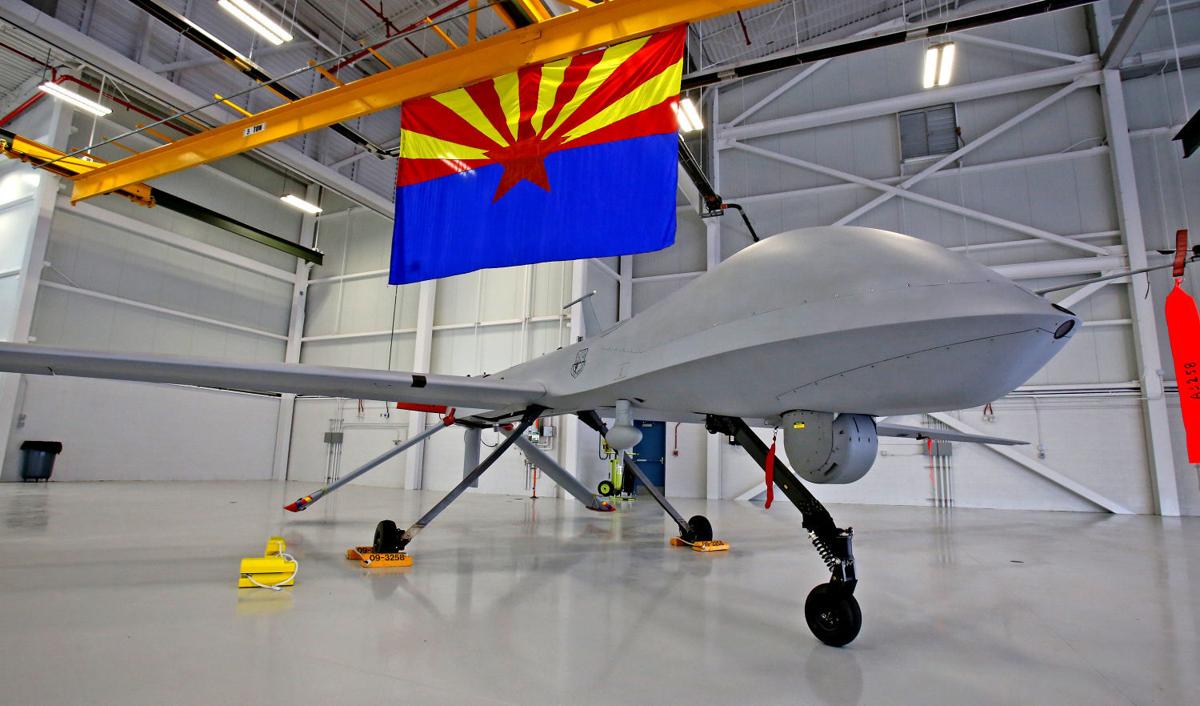The Air Force wants to vastly expand its drone program over the next five years by doubling the number of pilots and deploying them to bases around the country to give commanders better intelligence and more firepower.
Tucson’s Davis-Monthan Air Force Base — which stands to lose its biggest mission amid efforts to retire the A-10 ground-attack jet — is mentioned as a possible site for expanded drone operations.
Besides Davis-Monthan, those considered most likely sites for the program include Beale Air Force Base near Sacramento, California; Joint Base Pearl Harbor-Hickam near Honolulu; and Langley Air Force Base near Newport News, Virginia.
The $3 billion drone expansion plan, which must be approved by Congress, was unveiled Thursday after months of study that focused on a drone pilot force that commanders have described as overworked, undermanned and underappreciated.
The five new drone operations centers would cost about $1.5 billion to build, according to the Air Force. Some 400 to 500 pilots and crew personnel would be assigned to each base, for another $1.5 billion.
The proposed expansion comes as the Pentagon has intensified airstrikes on Islamic State targets in Iraq and Syria. Pilots and crews who operate the MQ-1 Predators and MQ-9 Reapers have struggled to meet a rising demand for aerial surveillance of war zones and other hot spots.
“Right now, 100 percent of the time, when a MQ-1 or MQ-9 crew goes in, all they do is combat,” Gen. Herbert “Hawk” Carlisle, head of Air Combat Command, which oversees drone operations, told Tribune News Service. “So we really have to build the capacity.”
The Air Force wants to add 75 Reapers to the current fleet of 175 Reapers and 150 Predators. It also would increase the number of flying squadrons from eight to as many as 17, and add up to 3,500 new pilots, sensor operators and other personnel.
Capt. Casey Osborne, chief of public affairs at D-M, said Friday that he has no official word on whether more drone operations will be based at D-M. That decision will “come from the top,” he said.
“That will be determined by the (Air Force) Secretary’s strategic bases process,” Osborne said. “Additional locations diversify assignment opportunities for personnel within the RPA (remotely piloted aircraft) enterprise, provide increased opportunities for leadership from within the community and may also provide flexibility to enhance integration with other organizations and capabilities.”
For now, drones can’t be flown in and out of D-M because the urban base doesn’t have a waiver from the Federal Aviation Administration to allow it.
Since 2007, D-M has hosted the 214th Reconnaissance Group, a unit under the Arizona Air National Guard 162nd Wing at Tucson International Airport that remotely flies Predator drones.
The 214th has equipment and pilots to remotely fly two drones, said 162nd Wing spokeswoman Lt. Lacey Roberts, but it has no aircraft at D-M.
As of February, the 214th had 188 personnel and had remotely flown more than 3,000 sorties and more than 55,000 flying hours of combat mission support over Iraq and Afghanistan, the Air Force says in a fact sheet.
The 214th’s first drone launch-and-landing facility — including a hangar and ramp that allows pilots to see their aircraft for practice takeoffs and landings — opened last year at Fort Huachuca’s Libby Army Airfield in Sierra Vista, where drones can operate under a federal airspace certification.
The Air Guard detachment at Libby has four MQ-1 Predator drones for training, Roberts said.
Under a long-term plan issued by the Air Force last year, three Predators in Arizona would be replaced by larger and more capable Reapers by fiscal year 2017.
It’s too early to say whether drones would actually be based at D-M if the base is identified as a site for drone operations, or if pilots at D-M would just operate those aircraft remotely, D-M spokesman Osborne said. If drones will actually fly out of D-M, the base would secure any required FAA approvals to ensure compliance with federal guidelines, he said.
Besides FAA approval, proposed new aircraft operations may trigger environmental studies under federal law to determine the likely impacts of any new aircraft operations, including noise, health and safety issues.
Unmanned aircraft are seen by Davis-Monthan supporters as a key area of potential mission expansion at the base as the Air Force moves to cut some existing missions here.
D-M stands to lose its biggest mission under Air Force plans to retire the A-10 Thunderbolt II ground-attack jet. But Congress has blocked such a move in the last two defense budgets, and Gen. Carlisle recently told reporters the Air Force is considering delaying its A-10 retirement plan.
Sen. John McCain, R-Ariz., has said D-M could host a larger drone mission — perhaps involving border surveillance and security in cooperation with the Department of Homeland Security. The DHS operates its own drones along the border out of Libby.
Ron Shoopman, a retired Air Force brigadier general and president of the Southern Arizona Leadership Council, said D-M could gain additional drone piloting squadrons even without basing unmanned aircraft here.
“Those (drone control) consoles can be here and they can fly missions in Afghanistan or wherever,” said Shoopman, who formerly commanded the Arizona Air Guard 162nd Wing.
The fact that drone pilots can be based anywhere may diminish D-M’s major flying advantages, including year-round flying weather and proximity to major training ranges, Shoopman said.
But the presence of the 214th and the nearby presence of the Army’s major unmanned-aircraft operator training center at Fort Huachuca weigh in D-M’s favor, he added.
Most Air Force drone missions around the world now are run from a single site, Creech Air Force Base, about an hour’s drive from Las Vegas. Multiple bases could allow drone crews to hand off responsibility for ongoing missions to take advantage of shifting time zones.





